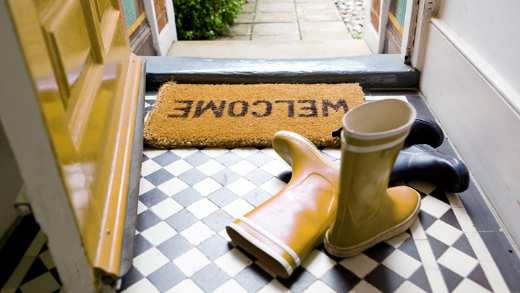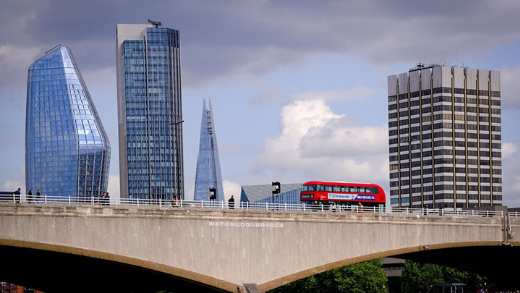Aviva calls for urgent action in creating climate-ready homes
Transcript for video Building Future Communities report
Protecting where we call home is essential to our lives and our wellbeing, and with climate change, that means ensuring that our urban and countryside communities are resilient to the extreme weather we increasingly face.
When a home floods, there's not just a financial cost for the people who live there. The emotional cost that comes with seeing a lifetime's possessions lost or damage can be devastating.
And after the storm, when the clean-up starts, there's also another cost to consider.
And that cost is one of carbon emissions.
Every time a property floods, there's a carbon footprint that comes with the repairs - which in turn further contributes to the challenges of climate change.
Analysis we've just completed suggests that the carbon cost of a UK flooded home without any resilience measures in place could be the equivalent to 6.5 return flights from London to New York.
In 2021 we outlined in Aviva's first Building Future Communities report, seven essential steps for improving the sustainability of homes and businesses, and helping the UK become more climate ready.
These included working to build resilience into our communities through strengthening planning regulations, collaborating across all stages of the building process and the materials used and encouraging property resilience.
Now, in our second Building Future Communities report, using data from our general insurance, home insurance claims and real-life case studies, we've modelled the potential carbon cost of a flood on a UK home.
Taking a three-bed semi-detached pre-1930s UK home, we compared the carbon cost of a major flood event in two different scenarios.
One when the property had no flood resilience measures installed, and the second with simple measures installed, such as flood doors, seal brickwork and raised electrical points.
The difference in outcomes was stark without any resilience measures in place, restoring a flooded home will produce 13.9 tonnes of carbon emissions, equivalent to 55 car trips from Land's End to John O’Groats, or 6.5 transatlantic return flights from London to New York.
We also found a major flood would lead to 750 millimetres of floodwater in the home and mean homeowners would have to move out for a considerable period.
Not surprisingly, the largest carbon impact in the flooded home came from replacing contents and restoring the building. By contrast, simple flood resilience measures led to a 64% reduction in the carbon cost of a flood and reduced the depth of the flood water to only 20 to 30 millimetres. And that's the difference between having to move out or being able to stay in your own home.
Until we consider how our UK property stock is prepared for a future of extreme weather, the more likely it is that we'll see storms, floods and heatwaves having a lasting impact on people's homes and lives as well as their businesses and livelihoods.
Collective action is needed, insurers have a role to play with their expertise in risk management, but so do government policymakers, planning authorities and the broader construction industry, as well as communities and householders.
We need to act now to ensure that our new and existing homes are resilient and robust for the effects of extreme weather.
- Analysis from Aviva’s claims data, in its latest Building Future Communities report, shows restoring a flooded home can create 13.9 tonnes of CO2 emissions1 - equivalent to six and a half return flights from London to New York.
- Emissions could be reduced by 64% through installing basic property flood resilience measures but only a third (35%) of residents have installed such measures2.
- The carbon impact is the unseen cost of a flooded property, in addition to the financial and emotional distress.
- Strengthened planning regulations, collaboration across all stages of the building process and incentivising resilience measures are among Aviva’s calls for change in the new report.
New analysis from Aviva shows the significant carbon impact of restoring a flooded home and calls for homes to be retrofitted and built resiliently to withstand a future of extreme weather.
Drawing on models from its claims data, Aviva’s second Building Future Communities report shows that the carbon cost of restoring a flooded home can be equivalent to six and a half return flights from London to New York or 55 car trips from Land’s End to John O’Groats1.
In its report, Aviva argues that building and restoring resilient UK properties is essential to tackling climate change and reducing emissions associated with flood damage. It calls on Government to introduce stronger planning regulations with resilience factored in, increase collaboration during all stages of the building process, and take steps to encourage and incentivise property resilience.
The carbon cost of a flood
Aviva calculated the carbon cost of a river flood event on a UK home - a three-bed, semi-detached, pre-1930s property. The insurer compared the carbon emissions due to the flood event in two different scenarios: one when the property had no flood resilience measures and the second with simple measures installed such as flood doors, sealed brickwork and raised electrical points. The outcome was very different, depending on whether resilience measures were in place.
Without any property flood resilience measures in place, Aviva found the carbon cost of restoring the flooded home was 13.9 tonnes of CO2 emissions. In addition, a home without resilience measures installed could lead to homeowners having to move out of their home for a considerable period.
Putting in place simple property flood resilience measures is projected to lead to a 64% reduction in the carbon cost of a flood and decrease the depth of flood water to 20-30mm. In turn, this means residents can remain in their homes which can help to lessen the emotional toll of a flood.
Adam Winslow, Aviva CEO of UK & Ireland General Insurance, calls on national and local government, planning authorities, the construction industry and insurers to work together to help strengthen the resilience of UK homes in the face of increasingly extreme weather events, as has been seen in the past year.
Winslow said: “Last year was a stark reminder of the very real impacts that climate change is having on the UK, with severe storms, record-breaking temperatures, wildfires and drought. It is clear that these weather patterns can no longer be called unusual.
“This new analysis underlines the link between protecting homes and reducing carbon emissions. Climate adaptation and mitigation can no longer be dealt with in silos. They must be addressed as two sides of the same coin. Failure to adapt buildings to cope with extreme weather could lead to more damage and a higher carbon cost in repairing that damage.
“It is critical that we work together to be climate-ready in all aspects of our lives, and that includes the regulations that stipulate how and where we plan, design and build homes, as well as how we restore them after a flood.
“As the government prepares to meet ambitious building plans, rightly to replenish our housing stock, it is essential that this is balanced with the need to focus on sustainable, low emission and resilient properties. Embedding resilience into new properties and restoring existing buildings with property flood resilience measures is vital if we are to minimise the emotional, financial and carbon costs of flooding.”
Impacts | Home without resilience measures | Home with resilience measures |
Carbon cost | 13.92 tonnes CO2e | 4.95 tonnes CO2e |
Financial cost (buildings and contents) | £67,663 | £24,000 |
Total drying time | 77 days | 10 days |
Time residents spent in alternative accommodation | 210 days | 0 days |
Waste volume | 24m3 | 12m3 |
In the Aviva analysis, the biggest savings in carbon emissions from property flood resilience measures were in building restoration, with a saving of 5.2 tonnes CO2e, largely due to lower water levels, which led to less damage in the home. In turn this meant fewer materials were needed to replace fixtures and fittings and less waste was produced. Emission savings were also made on the home contents (2.6 tonnes CO2e), as many items could be repaired rather than replaced. Importantly, carbon emissions associated with alternative accommodation – whereby a resident needs to move to temporary accommodation – reduced by 100% when resilience measures were installed because people were able to stay in their homes.
Household sentiment
The extreme weather of 2022 appears to have made people more aware of the threats of climate change. Research commissioned by Aviva found that 45% of people think climate change will impact their home in the next year, compared to 38% in 2021, rising to 65% in 10 years (2021: 57%).2 And although 80% of UK residents think homes should be resilient to extreme weather, the majority (67%)2 have not installed resilience measures in their homes.
Aviva’s calls for change
From the seven calls for change in its first Building Future Communities report, Aviva is calling for:
- Strengthen planning regulations to protect UK properties:
- including strengthened policy to avoid development in high-risk areas and the requirement to embed resilience measures where developments are granted
- More collaboration and research across all stages of the building process to combine sustainability with safety:
- including the alignment of building standards and planning policies with the UK’s Net Zero strategy
- Encourage and incentivise property resilience to aid recovery:
- including a role for incentives and other initiatives to boost UK household resilience
- including a role for incentives and other initiatives to boost UK household resilience
Winslow added: “With ambitious government plans to build new homes, it is crucial that any housing developments built on flood plains benefit from dual protection; flood defence systems to help prevent flooding in whole communities and resilience measures to minimise disruption. Unless more urgent action is taken to make our homes climate-ready, properties will be exposed to multiple threats from extreme weather, be it flooding, subsidence or over-heating. We simply cannot continue with the current status quo.
“Now is the time to act to make existing and future properties fit and prepared for the climate threats they will face in future.”
-ENDS-
Media enquiries:
Diane Mangan
General Insurance Lead
-
Phone
-
+44 (0) 7800 684 164
-
-
Email
Peter Thain
General Insurance & Broker
-
Phone
-
+44 (0) 7387 234796
-
-
Email
Footnotes:
1 - The homes modelled, and their contents, are theoretical, but based on a real claim made on a property insured by Aviva. In modelling the carbon emissions associated with a flood in these theoretical properties, best estimates of the Aviva claims team have been used, as both actual figures and national average figures are unavailable.
2 - Research commissioned by Censuswide for Aviva in July 2022
3 - Impacts calculated based on Aviva claims team estimates
Notes to editors:
- We are the UK's leading diversified insurer and we operate in the UK, Ireland and Canada. We also have international investments in India and China.
- We help our 19.2 million (as at 31 December 2023) customers make the most out of life, plan for the future, and have the confidence that if things go wrong we’ll be there to put it right.
- We have been taking care of people for more than 325 years, in line with our purpose of being ‘with you today, for a better tomorrow’. In 2023, we paid £25.6 billion in claims and benefits to our customers.
- In 2021, we announced our ambition to become Net Zero by 2040, the first major insurance company in the world to do so. We are aiming to have Net Zero carbon emissions from Aviva’s operations and supply chain by 2030. While we are working towards our sustainability ambitions, we recognise that while we have control over Aviva’s operations and influence on our supply chain, when it comes to decarbonising the economy in which we operate and invest, Aviva is one part of a far larger global ecosystem. There are also limits to our ability to influence other organisations and governments. Nevertheless, we remain focused on the task and are committed to playing our part in the collective effort to enable the global transition. Find out more about our climate goals at www.aviva.com/climate-goals and our sustainability ambition and action at www.aviva.com/sustainability
- Aviva is a Living Wage, Living Pension and Living Hours employer and provides market-leading benefits for our people, including flexible working, paid carers leave and equal parental leave. Find out more at https://www.aviva.com/about-us/our-people/
- As at 31 December 2023, total Group assets under management at Aviva Group were £376 billion and our estimated Solvency II shareholder capital surplus was £8.8 billion. Our shares are listed on the London Stock Exchange and we are a member of the FTSE 100 index.
- For more details on what we do, our business and how we help our customers, visit www.aviva.com/about-us
- The Aviva newsroom at www.aviva.com/newsroom includes links to our spokespeople images, podcasts, research reports and our news release archive. Sign up to get the latest news from Aviva by email.
- You can follow us on:
- X: www.x.com/avivaplc
- LinkedIn: www.linkedin.com/company/aviva-plc
- Instagram: www.instagram.com/avivaplc
- For the latest corporate films from around our business, subscribe to our YouTube channel: www.youtube.com/user/aviva
















